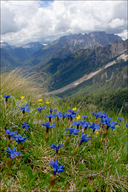|
|
click photo for larger file

Gentiana verna ssp. verna
Spring Gentian
|
Photographer: Dr. Amadej Trnkoczy
ID: 0000 0000 0515 1681 (2015-05-16)Copyright © 2015 Dr. Amadej Trnkoczy
|
|
INFORMATION PROVIDED WITH THE PHOTO
|
date of photo Jun 13, 2012
latitude 46.43707 longitude 13.63877
View on Google Maps.
location
Mt. Mangart region, Mangart's flats, along the Mt. Mangart's alpine road, beneath and above the last tunnel, East Julian Alps (Posočje, Slovenia)notes Slo.: spomladanski svišč, spomladanski zaspanček - syn: Gentiana verna ssp. alata - Habitat: stony grassland, near road side, full sun; dry, calcareous ground, exposed to direct rain, average precipitations ~ 3.000 mm/year, average temperature 1 - 3 deg C, alpine phytogeographical region. - Substratum: nutrients poor soil. - Comment: Gentiana verna is probably the most common and well known spring time species of this large, varied and beautiful genus. It grows mainly on nutrients poor grassland, largely at low elevations. However, it quite often climbs up to subalpine, sometimes even to alpine elevations. Here it can be easily falsely recognized as some other similar alpine species like Gentiana bavarica, Gentiana nivalis, Gentiana terglouensis, Gentiana favratii (syn.: G. orbicularis) or Gentiana pumila. All of these have beautiful, strikingly blue flowers of similar shape. Its best recognition trait are the lowest leaves, which are grouped in ground rosette (a more or less dense radiating cluster of leaves at the ground). The leaves are tapering to (not too) sharp pointed apex, have a distinct middle nerve and are up to 2 cm long. The lowest few rosette leaves (sometimes only one or two!) are significantly larger than other leaves - in average about twice as large, and are often hidden under surrounding greenery (look carefully at picture 10.). The second easy recognised discriminating parameter is presence of sterile rosettes (stems without flowers), which indicates a perennial plant and thus separates it from Gentiana nivalis, which is an annual plant. - Ref.: (1) Rothmaler 3, Exkursionsflora von Deutschland, 11. Aufl., Elsevier, Spectrum (2007), p 391. (2) A. Martinči et all., Mala Flora Slovenije, Tehnična Založba Slovenije (2007) (in Slovene), p 506. (3) D. Aeschimann, K. Lauber, D.M. Moser, J.P. Theurillat, Flora Alpina, Vol. 2., Haupt (2004), p 18. (4) M.A. Fischer, W. Adler, K. Oswald, Exkursionsflora Österreich Liechtenstein, Südtirol, LO Landesmuseen, Linz, Austria (2005), p 695.camera G11, 6.1-30mm/f2.8-4.5
contributor's ID # Bot_629/2012_IMG9735 photo category: Plant - annual/perennial
|
MORE INFORMATION ABOUT THIS PLANT
|
| common names
Spring Gentian (photographer)
View all photos in CalPhotos of Gentiana verna ssp. verna Check Google Images for Gentiana verna ssp. verna |
|
The photographer's identification Gentiana verna ssp. verna has not been reviewed. Click here to review or comment on the identification. |
|
Using this photo The thumbnail photo (128x192 pixels) on this page may be freely used for personal or academic purposes without prior permission under the Fair Use provisions of US copyright law as long as the photo is clearly credited with © 2015 Dr. Amadej Trnkoczy.
For other uses, or if you have questions, contact Dr. Amadej Trnkoczy amadej.trnkoczy[AT]siol.net. (Replace the [AT] with the @ symbol before sending an email.) |
|
|
